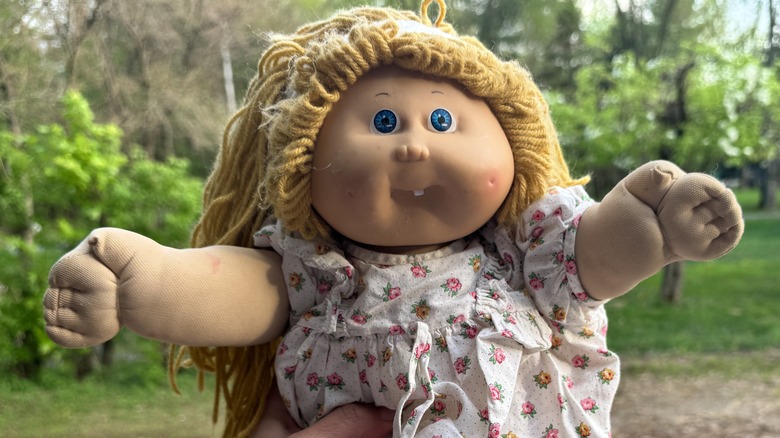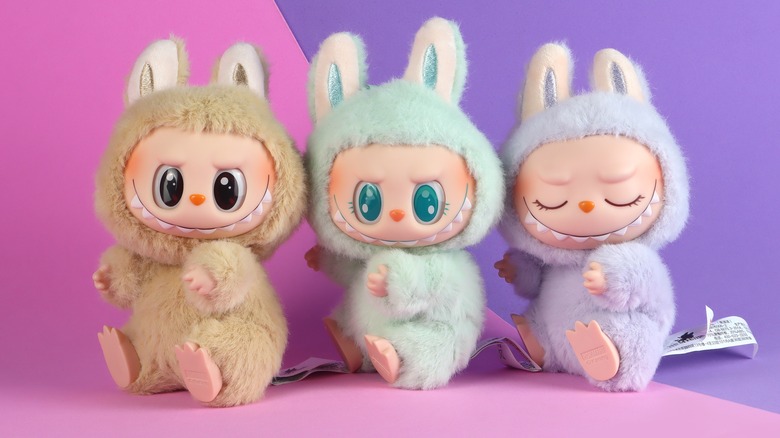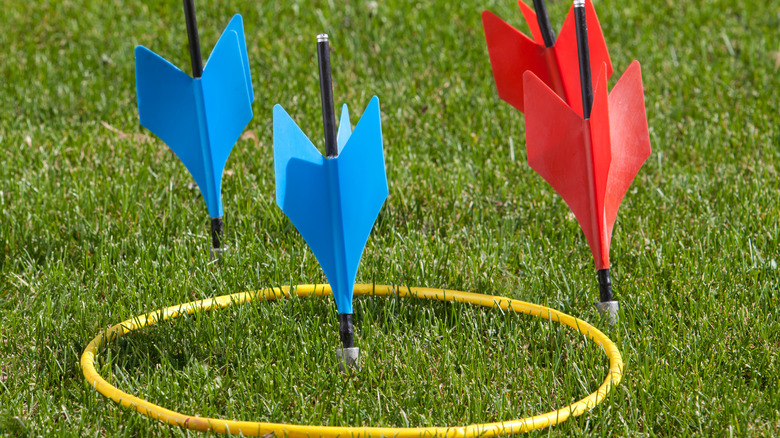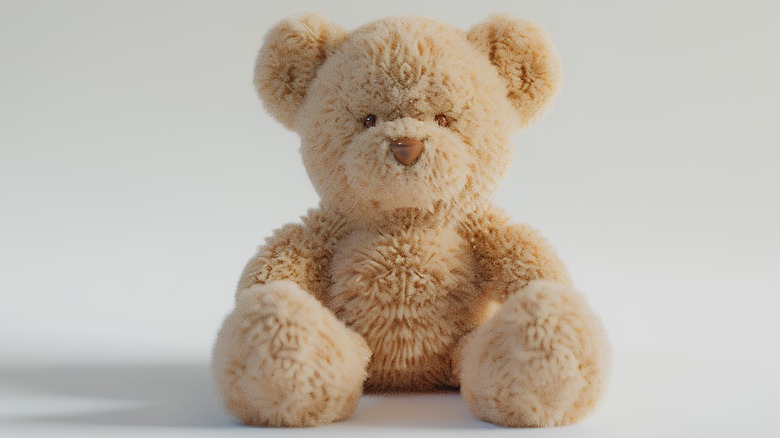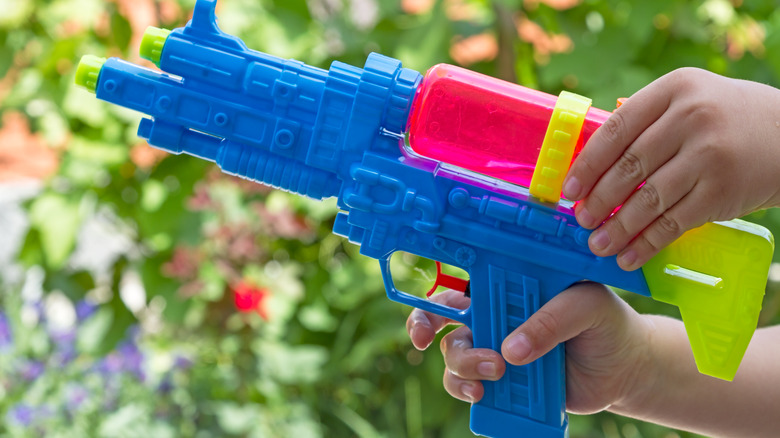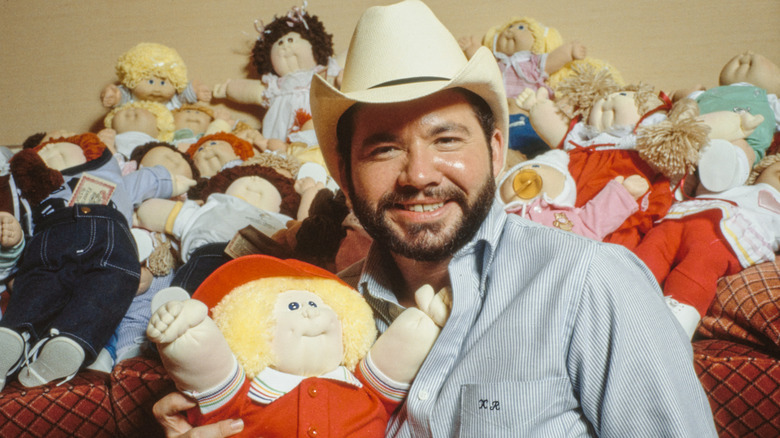Cult Classic Children's Toys With Dark Histories
While adults have plenty of things that could very well be classified as playthings, toys are most closely associated with childhood. If things are going well, a kid's whole world can revolve around toys. And that's just fine — they're sources of entertainment and fun that also help children learn about themselves and how the world works.
For the most part, toys are safe, wholesome, and appropriate for their intended audience of youngsters. Many become iconic because so many people buy them and so many people enjoy them, remembering the warm feelings and great times they provided long after they've broken or been put into a box and sent to a basement or thrift store. Other times, though, the most dangerous toys ever sold to the public cause destruction, and those hallmarks of childhood carry with them controversy, mystery, or bleakness. Here are some of the most fervently loved toys of all time that have dark histories, free of charge.
Labubu dolls
First appearing in Kasing Lung's "The Monsters" picture book series in 2015, Labubus are a group of furry, jagged-toothed, and mischievous elves. A toy line launched in 2015, but they became a sensation in 2025, sold in various collectible sizes and colors. They sell in such huge numbers that supply can't meet demand, so while one Labubu has a standard price of $27.99, they can move for more than five times that on the secondary market.
The desire to capitalize on the Labubu trend had led to various acts of recklessness and criminality. One night in August 2025, $30,000 worth of Labubus were forcibly removed from One Stop Sales in La Puente, California, by four burglars who broke through a glass door. Within two days, all of the dolls were recovered and returned. The following week, another $30,000 of Labubu stock disappeared from a warehouse in Chino, California, ultimately turning up at the nearby home of an individual who planned to sell them at inflated prices.
There's also the matter of counterfeit and rip-off Labubus. Closely resembling the real thing, they're billed as "The Monsters" and derisively nicknamed "Lafufus" by Labubu collectors. The toys are reportedly so shoddily produced that they could easily harm children who come into contact with them. The Consumer Product Safety Commission warned the American public in August 2025 to avoid phony Labubus, because they so easily fall apart into tiny pieces that could cause kids to choke.
Lawn darts
Lawn darts, alternately called jarts, is a backyard game similar to horseshoes or cornhole. It was commonplace throughout the 1980s, and a set of darts included plastic hoops to use as targets. Kids would throw oversized, weighted flying darts with a semi-sharp metal front end designed to stick into the ground upon impact. A sharp and heavy projectile was a disaster waiting to happen, and happen it did.
Over an eight-year span, 6,100 Americans were hospitalized for lawn dart injuries. More than 80% of those people were children 15 and younger, who sustained damage to their eyes, ears, head, and face. Some injuries were permanent, and sometimes they were fatal. While playing in her front yard in Riverside, California, in April 1987, 7-year-old Michelle Snow was struck by a lawn dart thrown by another child while in her backyard. The approximately 23,000 pounds of pressure per inch caused the dart to enter her skull, and she died three days later.
Snow's father, David, started a campaign to end the sale of lawn darts, only to find out that the toy nearly was pulled from stores until manufacturers agreed to reposition it as an adults-only game and slap on a warning label. Snow lodged a complaint with the Consumer Product Safety Commission, which determined that toymakers and stores had largely ignored the new regulations. In December 1988, lawn darts were permanently banned in the U.S.
Teddy bear
There are many chapters in the wild true story of Teddy Roosevelt. In addition to helping shape modern football and leading a battalion during the Spanish-American War, the president was an avid hunter of large game. During one track-and-kill excursion, Roosevelt decided against shooting a captured and restrained animal, which led to the invention of what might possibly be the most famous, innocuous, and cuddly toy of all time.
Mississippi Governor Andrew Longino asked then-President Roosevelt to join his hunting party on a trip outside the town of Onward in November 1902. Everyone present had managed to fell a bear — except Roosevelt. In the name of approval and appeasement, some of his employees located a black bear in the wild. They somehow managed to tie it to a tree and invited the president to take his shot at the defenseless animal. Calling out the lack of sport, Roosevelt wouldn't shoot the bear. That story leaked to the press, and editorial cartoonist Clifford Berryman produced a piece that made fun of the president for failing to shoot that bear.
After seeing that cartoon in the Washington Post, Brooklyn stuffed animal makers Morris and Rose Michtom crafted a small, soft toy bear that they called "Teddy's bear." Marketed with Roosevelt's blessing, the Michtoms introduced the stuffed bear to the market. It became such a phenomenon that they had to set up a factory operation, which evolved into the major toy company Ideal.
Super Soaker
Squirt gun technology was instantly revolutionized with the early 1990s retail arrival of Super Soakers. A line of pump-activated water shooters with big reservoirs, they expelled a lot of water very quickly and with a lot of pressure, making those pocket-sized, leaky, and cheap plastic water pistols obsolete. Within three years of availability, manufacturer Larami had sold 27 million of the next-generation $10 water guns.
Many of the kids who owned a Super Soaker during that first blush couldn't even use them. In June 1992, multiple schools across northern Virginia threatened to keep any Super Soakers students brought to end-of-the-year water parties. Two major chain stores in Boston banned the guns around the same time at the behest of the mayor, reacting to the death of a local teenager who had been shot to death after a Super Soaker fight got out of hand. Other reports of squirt gun play leading to real firearm activity were filed around the U.S., as were stories about individuals being blasted by Super Soaker-wielding strangers who'd filled the reservoirs with bleach.
Cabbage Patch Kids
The strange Cabbage Patch Kids craze helped define pop culture in the mid-1980s. Though the toys sold very well for many years after, they're most infamous for causing riots during the 1983 holiday season. Each soft doll had a squishy face, beady little eyes, and mock birth certificate and adoption papers with a unique name and identity. According to the lore, they were grown in vegetable plots. Produced by Coleco, Cabbage Patch Kids were designed and invented by Xavier Roberts, whose name appeared all over the toys' packaging and even on the dolls themselves. Originally called "Little People," those toys inspired the mass-manufactured ones that flew off the shelves.
At the peak of Cabbage Patch Kid mania in the weeks before Christmas 1983, some doubted the oft-told story that Roberts had come up with the toy on his own. "It was my idea," Appalachia-based doll maker Martha Nelson told The Christian Science Monitor, asserting her claim as the rightful originator of the line. "I started working on the design in 1971 and developed it over the years." Nelson says that in 1976, she met Roberts at a craft fair, and he asked her to supply some dolls for a state park gift shop in Georgia. After selling a few, Nelson ended the arrangement when she developed the fear that Roberts would steal the concept. Nelson sued Roberts for $1 million, and the parties settled out of court for an undisclosed amount.
